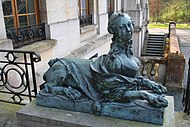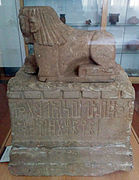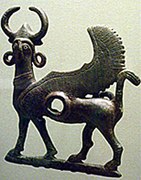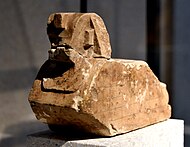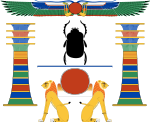斯芬克斯
 | |
| 分类 | 传说中的生物 |
|---|---|
| 地区 | 波斯语、埃及语和希腊语 |
斯芬克斯(Sphinx)最初源于古埃及的神话,是长有翅膀的怪物,通常为雄性,当时的传说中有三种斯芬克斯——人面狮身的Androsphinx、羊头狮身的Criosphinx(阿曼的圣物)、鹰头狮身的Hieracosphinx。亚述人和波斯人则把斯芬克斯描述为一只长有翅膀的公牛,长着人面、络腮胡子,戴有皇冠。到了希腊神话,斯芬克斯却变成雌性的邪恶之物,代表“神的惩罚”。“Sphinx”源自希腊语“Sphiggein”,意思是“拉紧”或“结合”,因为希腊人把斯芬克斯想像成一个会使人致死的怪物。
在希腊神话中,赫拉派斯芬克斯坐在忒拜城附近的悬崖上,拦住过往的路人,用缪斯所传授的谜语问他们,猜不中者就会被牠吃掉,这个谜语是:“什么动物早晨用四条腿走路,中午用两条腿走路,晚上用三条腿走路?腿最多的时候,也正是他走路最慢,体力最弱的时候。”俄狄浦斯猜中了正确答案,谜底是“人”,但斯芬克斯不服输,又给俄狄浦斯出了一个谜语:“什么东西先长,然后变短,最后又变长?”狄浦斯猜出了谜底“影子”。于是斯芬克斯羞愧万分,投海自溺而死(一说为被俄狄浦斯所杀)。据雅典的阿波罗多洛斯记载,斯芬克斯是厄喀德那同她的儿子双头犬奥特休斯所生。斯芬克斯的人面象征着智慧和知识。一说斯芬克斯之谜在更深层次的表现为“恐惧和诱惑”,即“现实生活”。
在欧洲的装饰艺术里,斯芬克斯随着文艺复兴而得到了很大的重视。随后,与古埃及相近的斯芬克斯形象传进各个其他文化中,尽管因为不同的描述而形象各异以及在不同文化传统里得到不同的发展。
一般来说,斯芬克斯常常与皇家的墓葬和宗教庙宇等建筑形式联系在一起。最早的已知斯芬克斯形象被发现在土耳其的公元前9500年的哥贝克力石阵。
雕像
|
主条目:狮身人面像 |
图片
-
阿蒙涅姆赫特三世的狮身人面像。第12王朝,公元前1800年。现存慕尼黑埃及艺术国家博物馆。
-
蒂沃利哈德良别墅发现的埃及狮身人面像,公元一世纪。现存慕尼黑埃及艺术国家博物馆。
-
两个狮身人面像形状的柱基。来自萨马尔。公元前8世纪。现存伊斯坦布尔考古博物馆。
-
赫梯狮身人面像、玄武岩。公元前8世纪。来自萨马尔。伊斯坦布尔考古博物馆。
-
波斯帝国苏萨大流士大帝宫殿的带翼狮身人面像,公元前480年
-
来自卡里亚首都哈利卡纳苏斯的阿契美尼德狮身人面像,公元前355年。发现于博德鲁姆城堡,但可能来自哈利卡纳苏斯陵墓。
-
雌性狮身人面像的头部,公元前1876-1842年。布鲁克林博物馆
-
1858年的狮身人面像
-
典型的埃及人头狮身人面像,现存都灵埃及博物馆
-
埃及哈特谢普苏特的狮身人面像,具有不同寻常的耳朵特征,公元前1503-1482年
-
从埃及进口的3000年前狮身人面像,用于装饰圣彼得堡和其他欧洲首都的公共场所。
-
无忧宫公园的斯芬克斯
-
克卢什宫的斯芬克斯
-
经典的摄政花园狮身人面像
-
1789-90年在巴伐利亚州阿沙芬堡公园的斯芬克斯
-
《俄狄浦斯与斯芬克斯》、让·奥古斯特·多米尼克·安格尔、1827年
-
《俄狄浦斯与斯芬克斯》、 居斯塔夫·莫罗、1864年
-
马德里、埃尔卡普里科公园的斯芬克斯
-
阁楼上大理石狮身人面像,公元前 580–575年
-
厄立特里亚阿迪格拉玛顿的狮身人面像
-
来自蒂尼苏特保护区的狮身人面像翅膀,公元一世纪,现存突尼斯纳布勒博物馆
-
早期埃及狮身人面像,第四王朝的赫特菲勒斯二世女王(现存开罗博物馆)
-
印章上的伊朗埃兰戈帕特 ,现存伊朗国家博物馆
-
伊朗的斯芬克斯铜器,现存克利夫兰艺术博物馆
-
伊朗的斯芬克斯黄金纹路,现存伊朗国家博物馆
-
埃及狮身人面像的雕塑模型。晚期,公元前664-332年。来自柏林新博物馆。
参见
参考文献
- 书籍
- Caldwell, Richard, Hesiod's Theogony, Focus Publishing/R. Pullins Company (1 June 1987). ISBN 978-0-941051-00-2.
- Clay, Jenny Strauss, Hesiod's Cosmos, Cambridge University Press, 2003. ISBN 978-0-521-82392-0.
- Gantz, Timothy, Early Greek Myth: A Guide to Literary and Artistic Sources, Johns Hopkins University Press, 1996, Two volumes: ISBN 978-0-8018-5360-9 (Vol. 1), ISBN 978-0-8018-5362-3 (Vol. 2).
- Kallich, Martin. "Oedipus and the Sphinx." Oedipus: Myth and Drama. N.p.: Western, 1968. N. pag. Print.
- Most, G.W., Hesiod, Theogony, Works and Days, Testimonia, Edited and translated by Glenn W. Most, Loeb Classical Library No. 57, Cambridge, Massachusetts, Harvard University Press, 2018. ISBN 978-0-674-99720-2. Online version at Harvard University Press (页面存档备份,存于互联网档案馆).
- Stewart, Desmond. Pyramids and the Sphinx. [S.l.]: Newsweek, U.S., 72. Print.
- Taheri, Sadreddin. Gopat (Sphinx) and Shirdal (Gryphon) in the Ancient Middle East. نشریه هنرهای زیبا- هنرهای تجسمی (Tehran: Honarhay-e Ziba Journal, Vol. 17, No. 4). 2013, 17 (4(زمستان 1391)) [2022-11-11]. doi:10.22059/jfava.2013.30063. (原始内容存档于2021-03-08).
外部链接
| ||||||||||||||||||||||||||||||||||||||||||||||||||||||||||||
| |||||||
| ||||||||||||||||||||||
Text is available under the CC BY-SA 4.0 license; additional terms may apply.
Images, videos and audio are available under their respective licenses.














